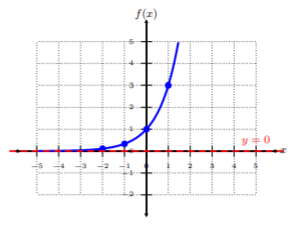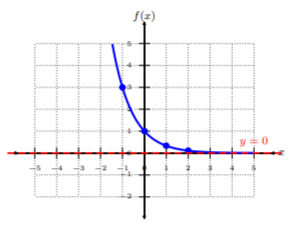12.2: Exponential functions
( \newcommand{\kernel}{\mathrm{null}\,}\)
Exponential functions take on their own set of solving and simplifying techniques since the equations are a bit different than before. For example, before we had something like x2=9, where we could take square root of each side to solve. However, if we had something like 3x=9, notice we cannot take the xth root of 9 because the index is unknown. However, we may notice that 32=9 and conclude that if 3x=32, then x=2. This is a simple example, but what if we had something a little more complex, like 10.98564x=34.9016? Then the value of x isn’t as obvious. These are the cases we address in this section and chapter.
One common application of exponential functions is population growth. According to the 2009 CIA World Factbook, the country with the highest population growth rate is tied between the United Arab Emirates (north of Saudi Arabia) and Burundi (central Africa) at 3.69%. There are 32 countries with negative growth rates, the lowest being the Northern Mariana Islands (north of Australia) at −7.08%.
An exponential function is a function of the form
f(x)=ax,
where f is a function of x, a>0 and a≠1.
Graph Exponential Functions
Let’s start to take a look at exponential functions by looking at their graphs.
Plot f(x)=3x by plotting points. From the graph, determine the domain of the function.
Solution
Let’s pick five x-coordinates, and find corresponding y-values. Each x-value being positive or negative, and zero. This is common practice, but not required.
| x | f(x)=3x | (x,f(x)) |
|---|---|---|
| −2 | f(−2)=3−2=19 | (−2,19) |
| −1 | f(−1)=3−1=13 | (−1,13) |
| 0 | f(0)=30=1 | (0,1) |
| 1 | f(1)=31=3 | (1,3) |
| 2 | f(2)=32=9 | (2,9) |
Plot the five ordered-pairs from the table. To connect the points, be sure to connect them from smallest x-value to largest x-value, i.e., left to right. Notice this graph is rising left to right, but, as the graph shoots to −∞ (to the left), it never touches the x-axis or intersects it, resulting in a horizontal asymptote at y=0. Since we see there are no restrictions to the graph, the domain is all real numbers or (−∞,∞).

Property 1. The domain of an exponential function is all real numbers, i.e., (−∞,∞).
Property 2. There are no x-intercepts; the y-intercept is at (0,1).
Property 3. If a>1, then the function is an increasing function. If 0<a<1, then the function is a decreasing function.
Property 4. There is a horizontal asymptote at y=0, unless there is a vertical shift.
An exponential function never crosses the x-axis. In fact, the general exponential function isn’t defined at f(x)=0. Take a look. If f(x)=0, then f(x)=0=ax. Ask, “For which value(s) of x such that a is raised to the power of x and the result is zero?” There exists no such x. We cannot raise a positive real number to a power and the result be zero. In the event an exponential function crosses the x-axis, then that means there was a transformation to the general exponential function.
Plot f(x)=(13)x by plotting points. From the graph, determine the domain of the function.
Solution
Let’s pick five x-coordinates, and find corresponding y-values. Each x-value being positive or negative, and zero. This is common practice, but not required.
| x | f(x)=13x | (x,f(x)) |
|---|---|---|
| −2 | f(−2)=(13)−2=9 | (−2,9) |
| −1 | f(−1)=(13)−1=3 | (−1,3) |
| 0 | f(0)=(13)0=1 | (0,1) |
| 1 | f(1)=(13)1=13 | (1,13) |
| 2 | f(2)=(13)2=19 | (2,19) |
Plot the five ordered-pairs from the table. To connect the points, be sure to connect them from smallest x-value to largest x-value, i.e., left to right. Notice this graph is falling left to right, but, as the graph shoots to ∞ (to the right), it never touches the x-axis or intersects it. Since we see there are no restrictions to the graph, the domain is all real numbers or (−∞,∞), and there is a horizontal asymptote at y=0.

Exponential Equations with a Common Base
Since the exponential function is one-to-one, we get the following.
To solve an exponential equation with a common base on each side of the equation, we use the fact that if
am=an, then m=n.
Solve the equation: 52x+1=125
Solution
We use the fact above to solve the equation.
52x+1=125Rewrite 125 as 5352x+1=53Common base, equate exponents2x+1=3Solve for x2x=2Divide both sides by 2x=1Solution
We can always check the answer by verifying the solution.
52x+1?=125Plug-n-chug x=152(1)+1?=125Simplify the left side53?=125Evaluate 53125=125✓ True
Since we obtain a true statement by verifying the solution, then x=1 is the solution.
Solve the equation: 83x=32
Solution
In this case, it may not seem as obvious at first, but if we rewrite each base as a common base, then we can apply the fact. Let’s rewrite each base as a common base of 2.
83x=32Rewrite 8 as 23 and 32 as 25(23)3x=25Multiply exponents 3 and 3x29x=25Common base, equate exponents9x=5Solve for xx=59Solution
We can always verify the solution, but we leave this to the student.
Solve the equation: (19)2x=37x−1
Solution
In this case, it may not seem as obvious at first, but if we rewrite each base as a common base, then we can apply the fact. Let’s rewrite each base as a common base of 3.
(19)2x=37x−1Rewrite 19 as 132(132)2x=37x−1Rewrite 132 as 3−2(3−2)2x=37x−1Multiply exponents −2 and 2x3−4x=37x−1Common base, equate exponents−4x=7x−1Solve−11x=−1Isolate xx=111Solution
We can always verify the solution, but we leave this to the student.
Solve the equation: 54x⋅52x−1=53x+11
Solution
In this case, it may not seem as obvious at first, but we need to apply the product rule of exponents and obtain only one common base on each side of the equation in order to apply the fact.
54x⋅52x−1=53x+11Apply product rule of exponents on the left side54x+2x−1=53x+11Simplify the exponent on the left side56x−1=53x+11Common base, equate exponents6x−1=3x+11Combine like terms3x=12Isolate xx=4Solution
We can always verify the solution, but we leave this to the student.
Notice, the examples only present a technique for solving exponential equations with a common base. However, not all exponential equations are written with a common base. For example, something like 2=10x cannot be written with a common base. To solve problems where we cannot rewrite the bases with a common base, we need the logarithmic function, which we will discuss in the next section.
Exponential Functions Homework
Graph each exponential function.
f(x)=4x
x(y)=(14)y
f(x)=−3x
q(r)=−(15)r
h(n)=(12)n
g(x)=2x
j(x)=−2x
k(t)=−(12)t
Solve the equation.
31−2n=31−3n
42a=1
(125)−k=125−2k−2
62m+1=136
6−3x=36
64b=25
(14)x=16
43a=43
363x=2162x+1
92n+1=243
33x−2=33x+1
3−2x=33
5m+2=5−m
(136)b−1=216
62−2x=62
4⋅2−3n−1=14
43k−3⋅42−2k=16−k
9−2x⋅(1243)3x=243−x
64n−2⋅16n+2=(14)3n−1
5−3n−3⋅52n=1
42x=116
16−3p=64−3p
625−n−2=1125
62r−3=6r−3
52n=5−n
216−3v=363v
27−2n−1=9
4−3v=64
64x+2=16
162k=164
243p=27−3p
42n=42−3n
6252x=25
2162n=36
(14)3v−2=641−v
2166−2a=63a
322p−2⋅8p=(12)2p
32m⋅33m=1
32−x⋅33x=1
43r⋅4−3r=164


